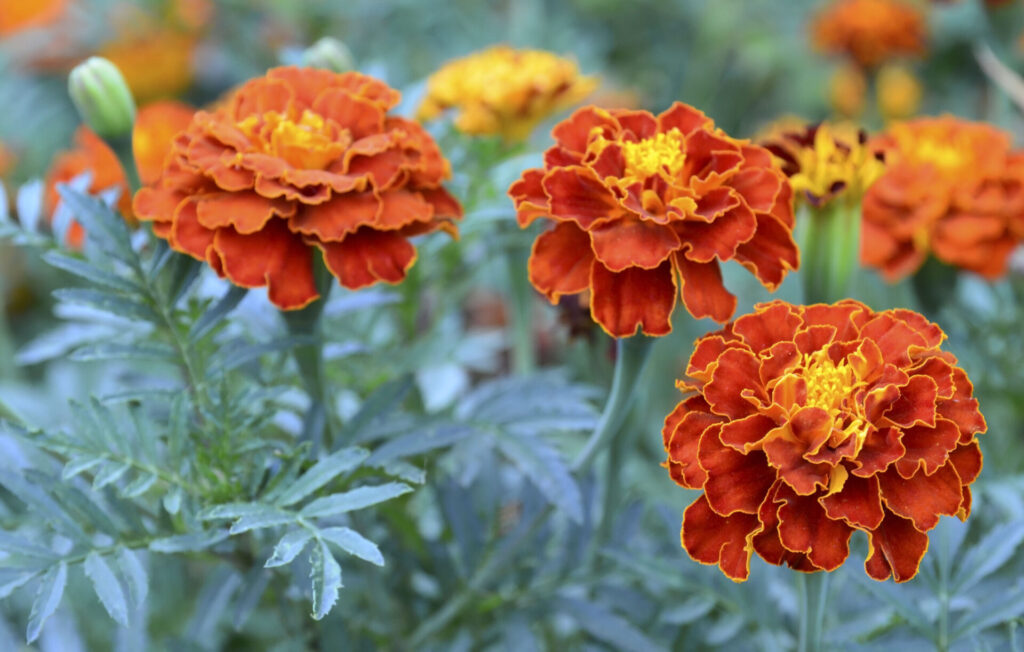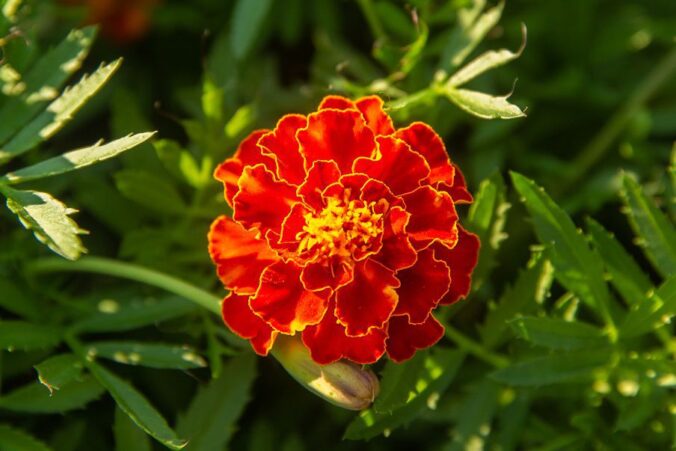Marigolds, with their vibrant hues and delicate petals, have woven themselves into the tapestry of cultures around the globe, holding a special place in the hearts and traditions of many. These resilient flowers boast a rich history that spans centuries, encompassing both practical and symbolic significance in various societies. From ancient rituals to modern-day celebrations, the marigold’s allure remains undiminished, captivating people with its beauty and symbolism.
Ancient Origins and Mythology

The history of marigolds traces back to ancient civilizations, where they were revered for their medicinal properties and mystical attributes. In Mesoamerican cultures, such as the Aztecs, marigolds held a sacred status, often used in religious ceremonies and offerings to the gods. The Aztecs believed that marigolds, known as cempasúchil in Nahuatl, possessed the power to guide spirits to the afterlife during the annual Dia de los Muertos, or Day of the Dead, celebrations.
Marigolds also found their place in Greek and Roman mythology, associated with deities like Apollo and the sun god, Helios. According to legend, marigolds sprang forth from the tears of Apollo’s beloved sister, Clytie, as she mourned his unrequited love for the sun god. This connection to the sun imbued marigolds with symbolism representing warmth, light, and renewal, making them popular additions to festive occasions and rituals honoring the sun.
Cultural Significance and Traditions
Across cultures, marigolds have been incorporated into various traditions and celebrations, serving as potent symbols of love, luck, and protection. In India, marigolds play a central role in festivals and religious ceremonies, adorning homes, temples, and wedding venues with their vibrant blooms. During Diwali, the Festival of Lights, marigold garlands and decorations symbolize prosperity and the triumph of good over evil, illuminating the festive atmosphere with their golden hues.
In Mexico, marigolds are synonymous with the Dia de los Muertos festivities, where they are used to create elaborate altars, known as ofrendas, to honor deceased loved ones. The bright colors and pungent scent of marigolds are believed to attract the spirits of the departed, guiding them back to the realm of the living for a joyous reunion. This tradition underscores the enduring connection between marigolds and the cycle of life, death, and rebirth, fostering a sense of continuity and reverence for ancestral heritage.
Botanical Characteristics and Varieties
Marigolds belong to the genus Tagetes, encompassing a diverse range of species and cultivars distinguished by their unique characteristics and growing habits. Common varieties include the African marigold (Tagetes erecta), with its large, showy blooms in shades of yellow, orange, and gold, and the French marigold (Tagetes patula), prized for its compact size and abundant flowers in vibrant hues of red, orange, and bi-color combinations. Large companies engaged in the production and distribution of flowers use excellent freight and logistic services in order to succeed in acquiring different varieties from all corners of the continent, but also to deliver them to their customers all over the world.
These resilient flowers thrive in a variety of climates and soil conditions, making them popular choices for gardeners and landscapers seeking low-maintenance blooms with lasting impact. Marigolds are also valued for their pest-repellent properties, emitting a distinct fragrance that deters insects and pests from infesting nearby plants, making them valuable companions in vegetable gardens and ornamental landscapes alike.
Medicinal and Culinary Uses
Beyond their ornamental appeal, marigolds boast a wealth of medicinal and culinary uses, harnessing their healing properties and distinctive flavor profiles in traditional remedies and culinary creations. In traditional medicine, marigold extracts are prized for their anti-inflammatory, antiseptic, and wound-healing properties, used topically to treat skin ailments, minor cuts, and burns. In addition, because they are edible, they can easily be used in some delicious sweets such as milk chocolate edibles for the double pleasure of something that is very sweet but also healthy.
In the culinary world, marigold petals add a pop of color and subtle flavor to a variety of dishes, from salads and soups to teas and desserts. The petals can be infused into oils, vinegars, and syrups, imparting a delicate floral aroma and golden hue to culinary creations. Additionally, marigold flowers are often candied or used to garnish dishes, adding a touch of whimsy and elegance to culinary presentations. In European culture and cuisine, marigolds are especially prominent in sweets and decorations of exceptional desserts and cakes, and if you rent a car in Beograd, you can visit one of the sumptuous restaurants and help yourself to these sweet delicacies.
Modern Applications and Symbolism
In the modern era, marigolds continue to captivate and inspire, finding new applications in various fields ranging from horticulture and herbalism to art and literature. Gardeners and florists appreciate marigolds for their versatility and resilience, incorporating them into floral arrangements, landscape designs, and urban green spaces to add a splash of color and vitality. Special marigold flower decorations adorn various events and celebrations as well as special places protected by access control systems from Philadelphia that you can also install in your home for added security.
Moreover, marigolds serve as potent symbols of resilience, optimism, and transformation, embodying the spirit of endurance and renewal in the face of adversity. Their cheerful blooms uplift spirits and brighten landscapes, serving as reminders to embrace life’s cycles of growth, change, and rebirth. Whether adorning festive celebrations or gracing everyday gardens, marigolds continue to enchant and inspire, weaving their timeless charm into the fabric of human culture and imagination. Marigold decorations add color and fragrance to special festivals and events changing the theme and setting standards of luxury and elegance, especially at some exceptional festivals or pet fairs attended by special spheres of people.
Cultural Festivals and Marigold Celebrations

Throughout history, marigolds have been integral to cultural festivals and celebrations, infusing joy and color into communal gatherings and cherished traditions. Across continents, from Asia to the Americas, marigold festivals showcase the enduring significance of these radiant blooms in local cultures and communities. In Thailand, the annual Pak Phraek Festival celebrates the marigold’s role in Thai culture, with vibrant displays and floral offerings adorning temples and streets during the Songkran, or Thai New Year, festivities. The festival serves as a testament to the marigold’s enduring popularity and cultural resonance in the Land of Smiles. Those who want to delve deeper into the special meaning of the marigold flower symbol throughout history can devote themselves to special research, and the Internet provider that manages IT services in San Antonio provides its users with an excellent Internet with which they can quickly and easily research all these details.
In Africa, marigolds are revered for their spiritual significance and healing properties, often featured prominently in rituals and ceremonies honoring ancestors and divine spirits. In countries like Nigeria and Zimbabwe, marigold festivals bring together communities to celebrate the harvest season and give thanks for the bounty of the earth. These vibrant celebrations underscore the deep-rooted connection between marigolds and the rhythms of nature, fostering a sense of unity and reverence for the natural world. These dedicated and exceptional events present sumptuous cheese boards on which various fruits of the harvest and various delicious specialties are tastefully displayed celebrating this event with unique festivities and rituals.
Environmental Impact and Sustainability
Beyond their cultural and aesthetic value, marigolds play a vital role in promoting environmental sustainability and ecological balance. As companion plants, marigolds emit natural compounds that repel pests and attract beneficial insects, serving as natural allies in organic gardening and pest management strategies. Their ability to deter harmful pests reduces the need for chemical pesticides, minimizing environmental pollution and preserving the health of soil and water systems. The promotion of these useful organic and natural pesticides significantly affects people’s environmental awareness, and if your business also needs good promotion, you can turn to an excellent Colorado Springs SEO company that will create a successful promotion plan for you.
Moreover, marigolds are renowned for their phytoremediation properties, absorbing toxins and heavy metals from contaminated soils and water sources. In polluted urban environments and industrial landscapes, marigolds offer a green solution to environmental degradation, helping to cleanse and rejuvenate ecosystems affected by human activities. Through their remarkable adaptability and resilience, marigolds exemplify nature’s capacity for regeneration and healing, inspiring efforts to protect and preserve biodiversity for future generations. As this is a nice ecological movement, you can dedicate yourself to planting marigolds in your yard as well, which will not only serve a better ecological footprint but also an overall better appearance of your home, in addition, you can visit an experienced transmission service in Buffalo and with the help of regular diagnostics and upgrades of your car work on leaving a smaller carbon footprint on your environment.
Artistic Inspiration and Creative Expression
Marigolds have long inspired artists, poets, and writers with their vibrant colors and timeless beauty, serving as muses for creative expression across various artistic mediums. In the realm of visual arts, marigolds have been immortalized in paintings, sculptures, and decorative arts, capturing their luminous blooms and intricate details for posterity. From the vivid brushstrokes of Vincent van Gogh to the delicate watercolors of Georgia O’Keeffe, artists have sought to capture the essence of marigolds and convey their symbolic resonance through art. Those who are dedicated to historical and artistic development, as well as the development of science, can understand this more deeply, and if science is not your strong point and you want to pass your exams and master difficult material, you can turn to an excellent science tutor in Boulder.
Similarly, marigolds have found their way into the literary landscape, appearing in poetry, prose, and folklore as symbols of love, longing, and spiritual transcendence. In Gabriel Garcia Marquez’s masterpiece, “One Hundred Years of Solitude,” marigolds symbolize the ephemeral nature of life and the cyclical rhythms of time, weaving a tapestry of magical realism that enchants readers and captivates the imagination. Across cultures and generations, marigolds continue to inspire creativity and evoke a sense of wonder and awe, transcending linguistic and cultural boundaries to unite humanity in a shared appreciation of beauty and artistry. The marigold as a symbol runs through various successful literary works that serve the good development of new generations, and members of youth organizations such as Readathon school fundraisers especially enjoy them while developing their good reading hobby.
Scientific Research and Horticultural Innovation
In recent years, scientific research has shed new light on the medicinal properties and horticultural potential of marigolds, unlocking their secrets for the benefit of human health and well-being. Studies have revealed the therapeutic effects of marigold extracts in treating various ailments, from inflammation and arthritis to digestive disorders and skin conditions. The bioactive compounds found in marigolds, such as flavonoids and carotenoids, exhibit antioxidant and anti-inflammatory properties that hold promise for pharmaceutical applications and herbal remedies. In addition, scientists are committed to finding the best treatment for autism so that children diagnosed with this condition receive the best and adequate therapy.
Furthermore, advancements in horticultural science have led to the development of new marigold cultivars with enhanced traits, such as disease resistance, drought tolerance, and extended bloom periods. Breeders and geneticists continue to explore the genetic diversity of marigolds, seeking to unlock their full potential for ornamental, culinary, and medicinal purposes. Through collaborative efforts and interdisciplinary research, scientists are harnessing the power of marigolds to address pressing challenges in agriculture, healthcare, and environmental sustainability, paving the way for a brighter and more resilient future. The development of such views moves in tandem with the development of new technologies made possible by the development of telecommunications and the demand for millimeter wave products found in telephones and radios.
Community Engagement and Social Impact

In communities around the world, marigolds serve as catalysts for social cohesion and community engagement, bringing people together to beautify public spaces, promote environmental stewardship, and support local economies. Community gardening initiatives, such as urban greening projects and school gardens, provide opportunities for people of all ages and backgrounds to connect with nature, learn new skills, and foster a sense of belonging and empowerment. In different cultures, the marigold symbol has been seen differently, and if you dedicate yourself to one of the excellent hospitality courses, you will be able to see for yourself those different views, and you will also learn about many tourist places and destinations that are worth visiting.
Moreover, marigold cultivation offers economic opportunities for small-scale farmers and artisans, providing a sustainable source of income through the sale of flowers, seeds, and value-added products. By promoting sustainable agriculture and entrepreneurship, marigold initiatives empower individuals and communities to create positive change and build resilient, inclusive societies. Through grassroots efforts and collective action, communities are harnessing the transformative power of marigolds to nurture vibrant, equitable, and sustainable futures for generations to come. In addition, the colorful flower festivals that are often held in Europe, which you can visit if you rent a car in Beograd, are dedicated to the growing development of horticulture and to presenting to the public the importance and beauty of different types of flowers and decorations in today’s urban world.
Innovation and Future Prospects
Looking ahead, the future of marigolds is filled with promise and possibility, as scientists, entrepreneurs, and advocates explore new avenues for innovation and collaboration. Advances in biotechnology, such as gene editing and tissue culture, offer exciting opportunities to enhance marigold traits and develop novel varieties with improved performance and value-added attributes. From disease-resistant hybrids to fragrant, long-lasting blooms, the next generation of marigolds holds the potential to revolutionize horticulture and meet the evolving needs of growers and consumers worldwide.
Furthermore, the growing interest in sustainable living and eco-friendly practices is driving demand for organic, locally grown flowers, creating opportunities for small-scale farmers and urban gardeners to cultivate marigolds using regenerative farming methods and agroecological principles. By embracing innovation and sustainability, the marigold industry can play a pivotal role in promoting environmental stewardship, fostering economic resilience, and nurturing thriving communities across the globe. As we embark on this journey of discovery and transformation, let us draw inspiration from the timeless beauty and enduring legacy of marigolds, as we strive to create a more vibrant, sustainable, and inclusive world for all.

